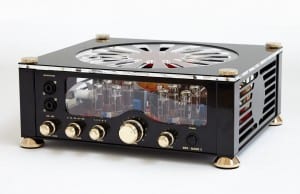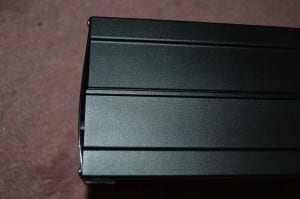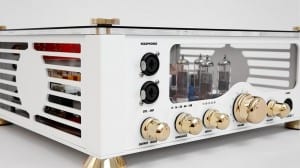« Headphone Month » at Hifi Pig continues with Janine Elliot’s review of the German AudioValve Verto and RKV Mk 3 headphone amplifiers costing £690 and £3262 respectively.
I was rather surprised when the Verto squeezed through the front door, particularly as this product  itself is only the size of a very large wallwart power supply. Luckily, my surprise turned to excitement when I dived down to the bottom of the massive box between the foam to find the RKV Mk3, a heavy eight-valve headphone amplifier behemoth accompanying this unit. During my few weeks with these products I had many more surprises, lots of excitement, and a lot of questions to ask.
itself is only the size of a very large wallwart power supply. Luckily, my surprise turned to excitement when I dived down to the bottom of the massive box between the foam to find the RKV Mk3, a heavy eight-valve headphone amplifier behemoth accompanying this unit. During my few weeks with these products I had many more surprises, lots of excitement, and a lot of questions to ask.
The Verto is a small black 110 x 105 x 165mm box with two Neutrik 6.3mm & XLR Combi sockets for XLR or dynamic and planar headphones, a three position silver knob to select the correct impedance, and a permanent short lead ending in a 6.3mm jack which is then connected to one of the two headphone sockets of the RKV (or to the headphone socket of your integrated amp). That is all quite normal. As well as a pair of loudspeaker connections what is slightly unusual is the Teflon 6-pin socket to power 300V and 580v 6 pin and 5 pin Stax electrostatic ear speakers. As a passive unit, and costing a reasonable £690, this unit uses transformers in step up mode with an array of capacitors to store up enough power to drive the electrostatics. Because the input wattage is very low (around 400mW) this can take several minutes. This technique is nothing new. Passive energisers like the Verto have been around before. Indeed, I remember with affection the late 1970’s PWB electrostatic headphones that took their power from the speaker terminals of your power amplifier. That was Peter Belt at his very best, before he and his wife got into somewhat questionable audio tweaks like sound-changing furniture polish and silver paper.
The Verto was originally designed for the RKV mark 1 and 2. Those two models only have the unique OTL output (Output Transformerless), a bit like my old EarMax headphones, so the switch for 8 and 32 ohm headphones on the Verto was quite useful. The RKV iii has provision for a wide range of low impedance cans as well, which therefore means a bit of duplication of features if both are used together. Since the Verto can be switched to 8 ohm you can connect loudspeakers to those speaker terminals, though with the Mark 3 RKV, with its own speaker outputs, there was no point in using this facility.
Whilst the VKR was a beautiful looking product the Verto was in comparison a Friday afternoon job,  being made of two halves joined together, and those joins were easily evident and spoilt my first impression of product build (see photo). The first two clicks on the silver knob on the front select 8 and 32 ohm impedance for the conventional headphones with the third position, OTL, for a Stax ear speaker. Unfortunately my Verto wasn’t going play music for me. The 6.3mm jacks only worked on the left leg and whilst I sat waiting endlessly for the LED on the front of the box to light up to tell me there was enough voltage to work the Stax, it was never going to shine. It reminded me of university days looking endlessly at my knickers revolving at 200mph in the campus washing machines. I really needed to connect a DAC with enough oomph to get this thing playing games, I mean music. I then connected the speaker jacks in reverse mode to my 250W Krell leviathan to see if that would drive the Stax but after 10 minutes there was no light and all I got was a very low level and no bass. Selecting conventional headphones did give me both legs working this time, but there was some hum, suggesting earthing damage on its trip across the English Channel. My role was as a reviewer, and not as fault finder, so I continued my review looking at the RKV mk3 as a conventional headphone amplifier. Such a shame, as I know this unit can sound so good.
being made of two halves joined together, and those joins were easily evident and spoilt my first impression of product build (see photo). The first two clicks on the silver knob on the front select 8 and 32 ohm impedance for the conventional headphones with the third position, OTL, for a Stax ear speaker. Unfortunately my Verto wasn’t going play music for me. The 6.3mm jacks only worked on the left leg and whilst I sat waiting endlessly for the LED on the front of the box to light up to tell me there was enough voltage to work the Stax, it was never going to shine. It reminded me of university days looking endlessly at my knickers revolving at 200mph in the campus washing machines. I really needed to connect a DAC with enough oomph to get this thing playing games, I mean music. I then connected the speaker jacks in reverse mode to my 250W Krell leviathan to see if that would drive the Stax but after 10 minutes there was no light and all I got was a very low level and no bass. Selecting conventional headphones did give me both legs working this time, but there was some hum, suggesting earthing damage on its trip across the English Channel. My role was as a reviewer, and not as fault finder, so I continued my review looking at the RKV mk3 as a conventional headphone amplifier. Such a shame, as I know this unit can sound so good.
AudioValve, not to be confused with Valve Audio, is a small German brand who has been making some quite iconic and mid-priced valve based audio since 1982. Like many an audio CEO, boss Helmut Becker was a musician, himself a guitarist and music enthusiast who began building amplifiers 40 years ago when he was 15. Indeed, his father was the owner of a small electronics business, and even as a 12 year old, Becker would often be seen tinkering with tube televisions in his father’s shop; taking them apart and getting to grips with the way they worked. Interestingly, his career has not just been devoted to audio, as it has also included numerous medical patents, including to fundamentally revolutionising analysis techniques for the detection of blood coagulation times.
Taking my first look at the RKV mark 3 was certain to increase my own blood pressure. The model  in this test was the third incarnation of the RKV, the original dating back to 1982. Just like the predecessors this larger 10kg 400 x 340 x 150mm monster was a sea of blackened steel and plastic (also available in silver or limited ivory editions), with large front and top Plexiglass windows that proudly revealed everything inside. You could sense the importance of showing the machinery that made it all ‘work’, and in this case included 8 valves towering from a bright red PCB, the terrain for a city of individually soldered components. It looked magnificent and needed to be seen! The components were all top class with a Pikatron transformer, OPA134 op amps, and a fully automatic biasing servo controller circuitry, which he has in all his amplifiers to regulate the valves. And the valves themselves, number PCL805, he designed himself. The previous incarnation had four of them.
in this test was the third incarnation of the RKV, the original dating back to 1982. Just like the predecessors this larger 10kg 400 x 340 x 150mm monster was a sea of blackened steel and plastic (also available in silver or limited ivory editions), with large front and top Plexiglass windows that proudly revealed everything inside. You could sense the importance of showing the machinery that made it all ‘work’, and in this case included 8 valves towering from a bright red PCB, the terrain for a city of individually soldered components. It looked magnificent and needed to be seen! The components were all top class with a Pikatron transformer, OPA134 op amps, and a fully automatic biasing servo controller circuitry, which he has in all his amplifiers to regulate the valves. And the valves themselves, number PCL805, he designed himself. The previous incarnation had four of them.
Having listened to and owned a sizeable collection of headphone amplifiers, the £3262 RKV is one of the most expensive. The instruction manual was very detailed, though the German to English translation was amusing in places; particularly the way it went from highly proficient and poetic nuances to phrases usually seen in the Chinese to English translations of cheap Amazon purchases. Apparently “the care tensions are won from a strong, free of litter, Torodial-transfomator”. Whether you are a big or small company the instruction manual is a core part of the package, and as such, detail should go into this vital component.
The top acrylic plate is machined with an array of ventilation slots for the tubes. The rest of the chassis is crafted from laser-milled stainless steel, rather than aluminium, as Becker says it ‘sounds’ better. The large red PCB and components are of the highest quality and hand soldered liberally and sensibly, and with affection.
On the front panel there are two combi headphone sockets, just as on the Verto, and below these is the Mode switch. This switch selects either high-impedance headphones (> 100 Ohms), or in the second position allows you to select from five low impedance (8, 16, 32, 64, 128 ohm) settings in the next knob. Why a single 6-position knob wasn’t used, I didn’t get a chance to ask.
With the last of the three rotary switches, you could select the source you want to listen to. The manual suggests that there were 45 RCA inputs at your disposal, but my limited algebraic knowledge brought that figure down to 5, or maybe 7. Let me explain; there are 5 RCA sockets (the fifth being a very simple, but useable “old school design” MM phono-stage input), and inputs 1 and 2 were paralleled with two XLR balanced inputs. There is a pair of speaker terminals, should you wish to drive the respectable 5.8W output into efficient drivers, though for my 4 ohm B&W 804s the output level was insufficient to drive them. Indeed, the sound quality was nothing to write home about. Completing the socketry is a pair of male XLR sockets to connect to a power amplifier. This piece of equipment was festooned with possibilities, and could easily be placed at the centre of a respectable hi-fi set up. Perhaps Mr Becker was trying to do too much in the reasonably priced £3262 presentation.
So to the tests. I wanted to ensure that, despite the imposition of Verto testing, this product was given an opportunity to shine. Not only did I listen to CD and vinyl sources, but I also included mp3 and FLAC.
One of the drawbacks of listening on headphones is that because of the closeness of the source to our ears we only hear an exaggerated sound stage, because none of what is in the left gets to the right, and vice versa, unlike with our ears when we are listening to live sources or loudspeakers. Angled ear speakers, such as Stax Lambda electrostatics, go part the way into making the experience less stressful, but this AudioValve unit has the provision to allow some of each channel’s information to reach the other channel, and which can narrow the soundstage, making it more realistic and, in their words, “less mental stress”. However, unlike those wonderful ambisonic recordings I listened to back in the 1970’s, there is no time delay, as there would be in reality. Indeed, it caused me a bit of mental stress trying to work out where exactly this facility was on the AudioValve. Again, an unclear instruction manual.
Now, you might be starting to think that all I do is criticise. I’d like to think that actually I just make sensible observations, and, once I started to listen to the sound, I wasn’t that bothered about my qualms anymore. Once I was constrained between the earpads of my Sennheiser’s, Audio-Technica’s and Grado’s, all I wanted to do was experience more and more of my vast archive of music. I found that with impedance adjustment my Audio-Technica’s sounded better than I had managed on any other headphone amp, though the Sennheiser HD650 was a bit too bass heavy. I listened to my Holst Planet Suite, Karajan (Decca 417 709-2), just as I had with the £190 Graham Slee Voyager test. There was much more weight in this offering, and the sound was more forward. It was more far more authoritive, largely due to the larger available output stage, and I had to be careful to set the impedance correctly and not turn the volume up too much. I felt at times the enormous powerhouse led to a little confusion in some of the music, compared to other amplifiers, and especially electrostatics. For that reason I then turned to a composer 8 hours away across the pond and a work composed 15 years later, Ferde Grofe and his Grand Canyon Suite (Naxos 8.559007). Both are programmatic works; this one is about donkeys wandering across the Arizona desert. It is a powerfully creative drama, something I fell in love with at the age of 10, when my imagination could whisk me across the Atlantic in an instant. This CD would be a great example to test the depth and power of soundstage and separation of instruments, particularly with a varied collection of distant brass instruments, glockenspiel, celesta, coconuts, wind machine and thunder maker. The instruments all came to life; the woodwinds sounding like birds and the trumpets like crickets. This was as real as it could get. There was richness in all the harmony, and at times it could sound a tad carried away in this powerful recording. The third movement has a lovely solo violin part, which, particularly through HD650’s, seemed to wander from left to right depending on whether there were low or high notes. Maybe it was a windy day in Arizona. The intense instrumentation in the fifth movement during the storm scene was, for most of the time, only a storm in a tea cup for this player.
I then turned to an equally complex hotchpotch, Martyn Bennett’s Grit, though this ‘busy’ album was a handled a lot more panache than in many headphone amplifiers. Pat Metheny Group The Way Up was as sweet as treacle; perfectly executed, with warm but musically precise cymbals, and again everything is up front, a very full sound, but just so right. Tube hiss was virtually non-existent (100dB S/N ratio) and, with a bandwidth from 10 – 150,000Hz, no instrument would be spared. This was more than fun, and took listening on headphones to a completely new level. This was no side salad; this was thick stew and dumplings. It was able, as its creator suggested, to render unparalleled “harmonic richness”. This machine was no slouch. It had the energy of the Scottish Independence YES voters. This was more than just an acoustic statement, more than just a headphone amplifier, and it was beautiful, too. My only worry was that it was perhaps though trying too hard to be everything to everyone.
Janine Elliot
Sound quality 8.55/10
Value for money 8.4/10
Build and design quality (RKViii) 8.5/10
Total 8.5
Price RKV Mk III £3262
Verto £690
How we carry out reviews.
Read more Hifi Review.



















































































































































































You must be logged in to leave a reply.